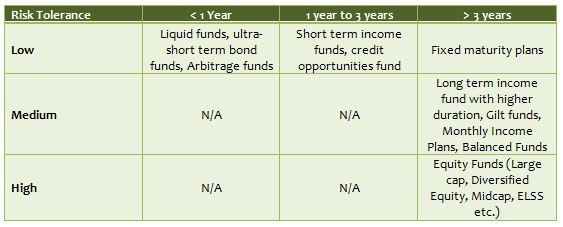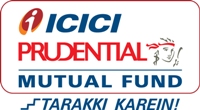How to select mutual funds based on your investment needs: Part 2

In the previous part of this blog, How to select mutual funds based on your investment needs: Part 1, we discussed that you should base your selection of mutual fund schemes on your investment goals. For each investment goal, we had discussed that, you should identify the following:-
- Investment Objective, capital appreciation or income generation
- Time horizon of your goal, short term, medium term or long term, in years
- Your risk tolerance and your appetite for volatility
- Your investment style, passive or active, and how much time you can devote to managing your investments
- Your liquidity needs
In this part, we will discuss in more details how to construct your mutual fund portfolio based on these considerations. Of the various investment goal related factors, discussed above, investment horizon and risk tolerance are interlinked. In general, the shorter the investor's horizon, the less risk he/she should be willing to accept. However, within the same investment horizon, the degree of risk tolerance may be different for different investors (as discussed in Part 1). The table below shows, the various investment options in mutual funds depending on the investment horizon and risk tolerance levels.

Let us now discuss these in more details, for each of these cases.
Investment Horizon less than one year:
If you need to park your cash for just a few months, then you should look at liquid funds, ultra-short term debt funds and arbitrage funds. If you need your funds within one to three months, then you should go for liquid funds (see our article, Top Liquid Mutual Funds: Better options than savings bank for parking your surplus cash). If you can wait for 6 to 12 months, then you should go for ultra-short term debt funds (see our article, What are the best options for parking your surplus cash in Mutual Funds Part 2). Ultra-short term gives slightly higher returns than liquid funds, but they may be volatile in the very short term (1 to 3 months). Withdrawals from liquid funds are processed within 24 hours on business days. Therefore, other than the funds that you need for your day to day expenses and an amount for contingency that you keep in your savings bank, you should consider parking your surplus cash in liquid or ultra short term debt fund. If you are in the highest tax bracket, arbitrage funds may be more tax efficient investment options for you (please see our article, Arbitrage Mutual Funds: A good short term investment option in volatile markets). Liquid fund returns will be taxed at your income tax rate, for investment holding period of less than 3 years. Arbitrage funds returns, on the other hand, for an investment holding period of less than a year will be taxed at 15%. For example, if you are in the 30% tax bracket, if an arbitrage fund gives you an annualized return of 7%, while a liquid fund gives you a return of 8%, you will be better, from a post tax perspective, investing in the arbitrage fund.Investment Horizon from 1 year to 3 years:
If you have a one to two three year time horizon, investing in short term income and credit opportunities funds are good investment options. Short term bond funds invest in Commercial Papers (CP), Certificate of Deposits (CD) and short maturity bonds. The average maturities of the securities in the portfolio of short term bond funds are in the range of 2 – 3 years. The fund managers employ a predominantly accrual (hold to maturity) strategy for these funds and hence the interest rate risk is low. In the current interest rate scenarios these funds are giving around 8 to 9% returns. However, if yields decline then the returns will be lower. Credit opportunities fund are similar to short term debt funds. To know more about short term debt funds, please see our article Top 5 short term debt mutual funds in 2015. In Credit Opportunities funds, the fund managers lock in a few percentage points of additional yield by investing in slightly lower rated corporate bonds. Despite the slightly lower credit rating of the bonds in the credit opportunities fund portfolio, credit risk should not be a concern for the investor because the funds invest in papers rated A and higher. In fact, on an average, majority of the bonds in the fund portfolios are rated AAA and AA. The average maturities of the bonds in the portfolio of credit opportunities funds are in the range of 2 – 3 years. The fund managers hold the bonds to maturity and so there is very little interest rate risk. Good credit opportunities funds have given double digit returns in the recent past.Investment Horizon of more than 3 years:
If your investment horizon is more than 3 years and you have low risk tolerance levels then, you should invest in fixed maturity plans. Fixed maturity plans (FMPs) are close ended schemes that aim to generate income for the investors in a fixed term. In the last one year, top performing FMPs have given better returns than bank fixed deposits even on a pre tax basis. On a post tax basis, FMP returns are even better compared to bank fixed deposits, because FMPs get indexation benefit on taxes. However, investors should note that since FMPs are close ended schemes, there is virtually no liquidity before the fixed term. If liquidity is an important consideration, then investors should opt for income funds. Between FMPs and income fund, the predictability of returns is higher in FMPs. FMPs are particularly suitable, in a high interest regime environment, where you can lock in higher yields. On the other hand, if interest rates are falling, income funds are more suitable. Income funds invest in a variety of fixed income securities such as bonds, debentures and government securities, across different maturity profiles. For example - they can invest in 2 to 3 year corporate non convertible debenture and at the same time invest in a 20 year Government bond. Their investment strategy is a mix of both hold to maturity (accrual income) and duration calls. This enables them to earn good returns in different interest rate scenarios. However, the average maturities of securities in the portfolio of income funds are in the range of 7 to 20 years. Therefore these funds are highly sensitive to interest rate movements and are suitable for investors with low to moderate risk tolerance levels (please see our article, Top 6 long term income funds in 2015). If you have slightly higher risk tolerance then, you should go for monthly income plans. Monthly income plans invest primarily in fixed income instruments, while maintaining a small allocation in equity instruments. They are suitable for investors with moderate risk tolerance, particularly retirees looking for regular income from their investments as well as a bit of capital appreciation (please see our article, Top 5 Mutual Fund Monthly Income Plans). Balanced funds on the other hand are suitable for investors, with a moderate to high risk tolerance level and a longer time horizon (5 years or more). These funds typically have 60 – 70% of the portfolio invested in equities and the rest in fixed income securities. These funds are suitable for investors, looking for capital appreciation, without assuming substantial risks on the capital invested. These funds are suitable for investors, who are 5 to 10 years away from retirement or other long term financial objectives. On a risk adjusted basis top performing balanced funds have delivered excellent returns compared to diversified equity funds (please see our article, How Balanced Mutual Funds created wealth for moderate risk takers).
If you have longer time horizon, say 5 to 10 years or more, and if you are willing to take more risks, then equity funds is the way to go. Investors should note that, equity as an asset class provides the highest returns in the long term. However, investors in equity funds do have to contend with volatility, which means that they cannot have a short time horizon. Top performing equity funds have given more than 15% compounded annual returns over the last 10 years, despite intervening bear market periods. Equity funds are suitable for long term financial objectives like, retirement planning, children’s education, children’s marriage, house purchase etc. There are a large number of investment options within equity funds like, large cap funds, diversified equity funds, Equity Linked Savings Schemes (ELSS), small & midcap funds, thematic funds etc which may cause the investor to be confused, as to which is the best investment option. What option is suitable for you depends on your personal situation, however, we will discuss several considerations which may help you make the appropriate choice:-
- Many investment experts believe that diversified equity funds, also known as flexicap or multicap funds, comprising of stocks across different market capitalization segments, are the best long term investment options for financial objectives like, retirement planning, children’s education, children’s marriage, house purchase etc. Diversified equity funds carry slightly more risk than large cap funds, but also give higher returns, compared to large cap funds (please see our article, Best Diversified Equity Mutual Funds: Consistent Performers for investment in 2015). At the same time, they are not as volatile as small and midcap funds.
- If tax saving is a consideration, then you should choose ELSS. Under Section 80C of Income Tax Act, investment in ELSS up to Rs 1.5 lakh (subject to the overall limit within Section 80C) is eligible for deduction from your taxable income and therefore will qualify as tax saving investment for you. ELSS funds have a lock in period of 3 years from the date of investment, and therefore will have an impact on your liquidity considerations. While tax saving is a big benefit for ELSS investors, these funds have given excellent returns, over various long term investment horizons (please see our article, Tax Planning: Review of top 6 Equity Linked Mutual Fund Saving Schemes)
- Large cap funds, which comprise mainly of large cap stocks, have the lowest risk among equity funds categories. Large cap funds, to some extent, limit downside risks in bear market conditions. However, it must be said, specifically in the Indian market context that, large cap fund performance is more sensitive to FII activity than small and midcap funds. In fact, in the market correction over the past 10 months, large cap funds have underperformed small and midcap funds. Based on historical performance, large cap funds have given slightly lower returns than diversified equity or flexicap funds and even lesser returns than small and midcap funds. However, many investment experts believe that large cap funds may outperform small and midcap funds in the near to medium term, since the valuations of many midcap companies are as rich, if not richer than their large cap counterparts (please see our article, Best mutual fund consistent performers in 2015: Large Cap Funds)
- Small and midcap funds are inherently more risky than large cap and diversified equity funds. But these funds have the potential to give higher returns (please see our article, Best Small and Midcap Mutual Funds: Consistent performers for investment in 2015). However, it is important to ensure a optimal balance, consistent with your risk tolerance profile, between large, mid and small cap segments in your investment funds should constitute, only a portion of your equity funds portfolio. Though there are no hard and fast rules for allocations to midcap funds, there are some broad guidelines (subject to the personal financial situation and the risk tolerance level of the individual investor):-
- Very aggressive risk tolerance: 80% large cap / diversified equity and 20% small & midcap
- Aggressive risk tolerance: 85 – 90% large cap / diversified equity and 10 – 15% small & midcap
- Less aggressive risk tolerance: 95% large cap / diversified equity and 5% small & midcap
Conclusion
In this article, we have discussed how you can construct your mutual fund portfolio, based on the investment horizon of your various investment goal related factors. A thoughtfully constructed investment portfolio will ensure success in meeting your financial objectives. You should discuss with your financial advisor, what investment options are suitable to meet the objectives in your financial plan.
RECOMMENDED READS
LATEST ARTICLES
- Why you need to have hybrid mutual funds in your portfolio: Different types of funds Part 2
- Why you need to have hybrid mutual funds in your portfolio: Misconceptions Part 1
- Which is the best time to invest in mutual funds
- Economic slowdown: Is it real and what should you do
- Importance of liquidity in investing: Mutual funds are ideal solutions
An Investor Education Initiative by ICICI Prudential Mutual Fund to help you make informed investment decisions.
Quick Links
Follow ICICI Pru MF
More About ICICI Pru MF
POST A QUERY




